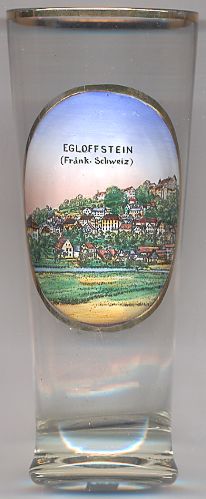

|
| DEUTSCHLAND | GERMANY |
| Bundesland: Freistaat Bayern | Bavaria |
| Regierungsbezirk: Oberfranken | |
| Landkreis: Forchheim |
 Egloffstein is situated at an elevation of 416 m in the slopes of the Trubach valley in the Forchheim district of Upper Franconia.
The municipality has a population of about 2,000 (2007).
Egloffstein is situated at an elevation of 416 m in the slopes of the Trubach valley in the Forchheim district of Upper Franconia.
The municipality has a population of about 2,000 (2007).
 Egloffstein castle [top right]
was the seat of the lords of Egloffstein since before 1180. The earliest written documents mentioning the castle date from 1180 and 1184 and refer
to a Salmann (escrow, notary) named Henricus de Hegelofuesten or Heinricus de Agilulfi lapide. In 1509 the castle became a fief of
the bishops of Bamberg, but it remained in possession of the Egloffstein family until today.
Egloffstein castle [top right]
was the seat of the lords of Egloffstein since before 1180. The earliest written documents mentioning the castle date from 1180 and 1184 and refer
to a Salmann (escrow, notary) named Henricus de Hegelofuesten or Heinricus de Agilulfi lapide. In 1509 the castle became a fief of
the bishops of Bamberg, but it remained in possession of the Egloffstein family until today.
The village of Egloffstein, located beneath the castle, was burnt down in 1525 during the Pesants' War. The Reformation was introduced in 1561. During the Thirty Years' War (1618–1648) Egloffstein was again burnt down twice. With the Reichsdeputationshauptschluss of 1803 the secular sovereignty of the prince bishops of Bamberg was abolished and their territories were incorporated into the electorate (1806 kingdom) of Bavaria. In 1956 Egloffstein was officially recognized as a climatic spa. In 1959 the village was granted the status of a market town. In the course of the administrative reform of 1978 the neighbouring municipalities of Affalterthal and Bieberach, and parts of Hundshaupten and Zaunsbach, were incorporated into Egloffstein.
Notable members of the Egloffstein family were:
Leopold II of Egloffstein, Prince Bishop of Bamberg (1335–1343).
Johann I of Egloffstein, Prince Bishop of Bamberg (1400–1411), founder of the first university of Würzburg (1402).
Julie, Countess of Egloffstein (1792–1869), court lady and esteemed painter at Weimar, a confidante of Johann Wolfgang von Goethe.
![[scale]](lineal.jpg)